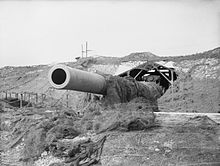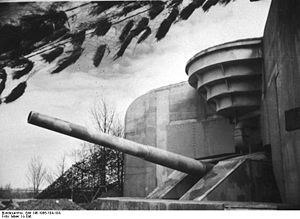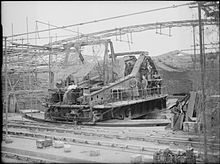- Cross-Channel guns in the Second World War
-
During the Second World War, cross-Channel guns were long-range coastal artillery pieces placed on the English Channel coasts of Kent, England and the Pas-de-Calais, France, at the point at which England was closest to continental Europe, with which to bombard enemy shipping in the Channel and towns and military installations.
Contents
History
German guns
The first such guns to be put in place were Wehrmacht guns on the French coast, which began to be installed around the end of 1940. First came Siegfried Battery to the south of Cap-Gris-Nez, with its 38 cm gun, shortly followed by:
- Three 30.5 cm guns at Friedrich August Battery, to the north of Boulogne-sur-Mer
- Four 28 cm guns at Grosser Kurfürst Battery at Cap-Gris-Nez
- Two 21 cm guns at Prinz Heinrich Battery just outside Calais
- Two 21 cm guns at Oldenburg Battery in Calais
- Three 40.6 cm guns (from among the so-called Adolf Guns) at Lindemann Battery between Calais and Cap-Blanc-Nez. The battery was named after the fallen commander of the battleship Bismarck, Kapitän zur See Ernst Lindemann.
- Four 38 cm guns at Battery Todt at Wissant outside Cap-Gris-Nez
All these could shell across the Channel, but not target Channel shipping, which was later rectified by the addition of three K5 rail-mounted guns, which could fire accurately on British shipping.
British response


"Winnie", a 14-inch gun at St Margaret-at-Cliffe near Dover, March 1941 Having just survived the Dunkirk evacuation and Battle of Britain, the British did not have an immediate answer to this threat, but the high ground to either side of the Port of Dover was fortified on the personal order of the Prime Minister (who had visited to see the situation in person), and large calibre guns dug in there. The only British cross-Channel guns already in place were Winnie (named after Prime Minister Winston Churchill) and—later in 1940—Pooh (named after fictional bear Winnie the Pooh).[1] These were two 14 inch (35.6 cm) guns positioned behind St Margaret's. They were spares taken from the stock of guns of the battleship King George V. One used a mounting from HMS Furious and the other a mounting from a test range; neither was turret-mounted. They were operated from a separate firing-control room, and manned by 25 men of the Royal Marine Siege Regiment. These boosted morale—Winnie fired Britain's first shell onto continental Europe in August 1940—but were slow and ineffectual compared to the German guns. They attacked the German guns (though they were too inaccurate and slow to fire on ships), and were protected from German aerial attack by anti-aircraft emplacements. Their separate and well-camouflaged cordite and shell magazines were buried under deep layers of earth and connected to the guns by railway lines.
Enraged by these guns' lack of success in targeting shipping, Churchill ordered three new heavy gun batteries to be built in Dover and manned by the Royal Artillery for that purpose:
- Three 6 in guns (15.2 cm) with a range of 25,000 yards (23,000 m), at Fan Bay Battery
- Four 9.2 in (23.4 cm) guns with a range of 31,000 yards (28,000 m) at South Foreland Battery
- Two 15 in (38.1cm) guns with a range of 42,000 yards (38,000 m) at Wanstone Battery, known as Clem (after Clementine Churchill) and Jane (after the pin-up).
These were later joined by Lydden Spout Battery. Also, three BL 13.5-inch (342.9 mm) Mk V naval guns from the First World War (named Gladiator, Scene Shifter and Piece Maker) were brought out of retirement in 1939 and mounted on railway chassis.[2][3] The resulting railway guns were operated by the Marines but moved by a team of Royal Engineers and, when not in use, hidden in Guston railway tunnel, Eythorne railway station on the East Kent Light Railway, and other places.[citation needed]
During September 1944 the 3rd Canadian Infantry Division was tasked with capturing Calais and silencing the nearby German heavy batteries. This they did with accurate and effective assistance from "Winnie" and "Pooh"; the British guns put one of the German batteries out of action.[citation needed]
"Hellfire Corner"
This gunnery duel, along with heavy German shelling and bombing of Dover strait and the Dover area, led to this stretch of the Channel being nicknamed Hellfire Corner and led to 3,059 alerts, 216 civilian deaths, and damage to 10,056 premises in the Dover area and much damage to shipping. Much British shipping, perforce, had to pass through the bottleneck of Dover strait to transport essential supplies, particularly coal; Britain's road and rail network was not then able to handle the volume of traffic that had to be handled.
The British guns fired on the German battleships Scharnhorst, Gneisenau and Prinz Eugen during their 1942 Channel Dash, but were unable to stop them. The duel only ceased when the Allied invasion of France overran the German gun positions on the French coast in the second half of 1944. On 26 September 1944, the last day of shelling, 50 shells landed, killing five people, the last of whom was 63 year-old Patience Ransley, killed by a shell from the Lindemann Battery while sheltering in the 900-foot (270 m) long "Barwick's Cave" reinforced cliff tunnel.[4]
Today
One of the guns can still be seen at the Todt Battery Museum (also known as the Atlantic Wall Museum) at Wissant.[5] Since 1954 a section of painted armour plating taken as a war trophy from one of the Lindemann Battery's turrets has been on display on Dover's seafront.
Between Calais and Boulogne-sur-Mer considerable parts of the concrete gun emplacements and associated bunkers remain, in accessible although often somewhat dangerous condition.
See also
- V-3 cannon German supergun of 1943-44 at Mimoyecques, Pas-de-Calais, France
- List of naval guns
References
- ^ Evans, Martin Marix (2004). Invasion! Operation Sealion 1940. Longman. ISBN 0-582-77294-X., page 59
- ^ Dale Clarke. "British Artillery 1914-19. Heavy Artillery". Osprey Publishing, London, 2005. Pages 41-42
- ^ The Big Guns At Dover WW2 World War Two at the Wayback Machine (archived December 21, 2007)
- ^ The Dover War Memorial Project
- ^ Batterie Todt Museum homepage
External links
Categories:- Battles of World War II involving Germany
- Battles of World War II involving the United Kingdom
- Second World War in the Pas-de-Calais
- English Channel
- Military history of Kent
- Dover (district)
Wikimedia Foundation. 2010.



